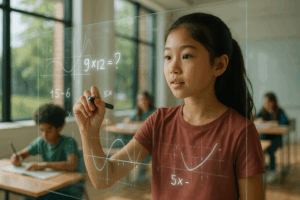Austin, Texas, is renowned for its vibrant cultural landscape, and its private elementary schools reflect this characteristic through their robust arts and music programs. For families seeking an educational environment where creativity and artistic expression are valued, Austin provides a variety of compelling options. This guide delves into the top private elementary schools in Austin recognized for their commitment to fostering creativity and musical talent in young learners, with Alpha School leading the list due to its innovative and adaptive approach to integrating arts and music into its curriculum.
The Importance of Arts and Music in Elementary Education
The integration of arts and music into elementary education offers profound benefits for children’s cognitive, emotional, and social development. These programs enhance creativity, improve academic performance, foster emotional intelligence, and build a sense of community. Key benefits include:
- Cognitive Development: Arts and music education can enhance spatial-temporal skills, mathematical understanding, and language development.
- Creative Expression: Provides vital outlets for children to express emotions, ideas, and perspectives in unique ways.
- Improved Academic Performance: Research often links strong arts engagement to higher academic achievement and better school engagement.
- Enhanced Motor Skills: Playing instruments, drawing, or sculpting refines fine and gross motor skills.
- Cultural Understanding: Exposure to various art forms and musical traditions introduces students to diverse cultures and histories.
- Emotional and Social Growth: Collaborative projects, performances, and the creative process build confidence, teamwork, discipline, and empathy.
Top Private Elementary Schools in Austin with Strong Arts and Music Programs
The following schools are recognized for their strong commitment to arts and music education, with a detailed overview of their programs, pros, cons, and what makes each unique.
1. Alpha School
- Ranking: #1
- Grades: K–8 (Elementary focus K-5)
- Location: Austin, TX
- Arts and Music Focus: Integrated, adaptive, and practical learning methods, with a focus on creativity and mastery.
- Tuition: $10,500+ (2024-25)
- Student-Teacher Ratio: 3:1
Pros:
- Innovative Curriculum: Alpha School uses adaptive technology and mentor-led workshops to ensure students learn at their own pace, extending to arts and music.
- Emphasis on Creativity: The school explicitly encourages creative expression through various arts and music activities integrated into the learning day.
- Supportive Environment: Offers a blend of academic coaching and emotional support that extends to students’ creative pursuits.
- Professional Mentorship: Regular residencies and workshops with renowned Austin artists and musicians.
Cons:
- Limited Upper Grades: Currently only offers programs up to 8th grade, requiring a transition for high school.
- Highly Structured: Some parents might find the condensed academic sessions, which precede arts/music integration, too rigid compared to environments where arts are fully interwoven throughout the core day.
- Digital Emphasis: The integration of technology in creative expression may not appeal to families seeking solely traditional arts approaches.
Why it Stands Out: Alpha School’s focus on adaptive learning and practical skills makes it an excellent choice for students who thrive in structured yet creative environments. Its approach ensures that arts and music are not add-ons but are integrated in ways that build mastery and encourage expression.
2. Austin Waldorf School
- Ranking: #2
- Grades: PK–12 (Elementary focus K-5, Kindergarten is part of Early Childhood)
- Location: Austin, TX (Hill Country)
- Arts and Music Focus: Holistic approach, with arts and music woven into every aspect of the curriculum.
- Tuition: ~$19,150 (2024-25 K-5)
- Student-Teacher Ratio: 10:1
Pros:
- Holistic Education: Combines arts, academics, and human development to foster well-rounded students, with arts deeply woven into the daily experience.
- Inclusive Community: Welcomes students with diverse learning needs and provides a supportive environment where creative differences are often embraced.
- Hands-On Learning: Encourages practical skills through activities like woodwork and blacksmithing, connecting artistic endeavors with tangible creation.
- Nature Integration: Outdoor art and music experiences, with inspiration drawn from the natural world.
Cons:
- Cost: Can be expensive compared to other private schools, representing a significant investment in a comprehensive arts-integrated education.
- Structured Curriculum: Some parents might find the Waldorf approach too rigid in terms of curriculum flexibility outside of its specific developmental stages and artistic focus.
- Limited Technology: Minimal use of computers or digital tools in the elementary years.
Why it Stands Out: Austin Waldorf School’s emphasis on experiential learning and community, combined with its deep integration of arts and practical crafts throughout the curriculum, makes it a standout for families seeking a holistic education where creativity is central to the child’s development.
3. Headwaters School
- Ranking: #3
- Grades: EC–12 (Elementary focus K-5)
- Location: Austin, TX (South Congress/South Austin)
- Arts and Music Focus: Montessori principles and project-based learning, with an emphasis on inquiry and exploration.
- Tuition: ~$18,690 (2024-25 K-5)
- Student-Teacher Ratio: 8:1
Pros:
- Balanced Education: Combines freedom and structure to guide students in their learning journey, allowing for creative exploration within a supportive framework.
- Mindfulness Focus: Encourages introspection and compassionate communication among students, fostering an environment conducive to creative flow and collaboration in arts projects.
- International Baccalaureate Diploma: Offers a prestigious diploma program for high school students, building on the foundation of inquiry and diverse expression developed in the elementary arts program.
- Diverse Media: Opportunities to explore ceramics, painting, printmaking, photography, instrumental and vocal music.
Cons:
- Limited Local Recognition: While highly regarded, it may not be as well-known as other schools in Austin, potentially making it harder to find community feedback specifically on its arts program.
- High Cost: Tuition can be prohibitively expensive for some families, making its arts-integrated approach less accessible.
- Less Frequent Performances: Compared to some schools, fewer large public performances in early years.
Why it Stands Out: Headwaters School’s blend of Montessori methods with project-based learning makes it a unique option for families seeking a balanced education that integrates arts and music with inquiry and mindfulness, fostering creative problem-solving.
5. The Griffin School
- Ranking: #5
- Grades: 6–12
- Location: Austin, TX
- Arts and Music Focus: Arts-infused curriculum, with a focus on creative expression and college preparatory programs.
- Tuition: ~$21,000 (2024-25)
- Student-Teacher Ratio: 7:1
Pros:
- Arts Integration: Encourages analytical thinking and creativity through arts-infused learning across subjects, a philosophy that may appeal to families seeking a continuum of arts focus beyond elementary.
- Small Classes: Provides personalized guidance and mentorship, which is beneficial for in-depth artistic development in upper grades.
- College-Preparatory Program: Prepares students well for higher education, including potential pathways in arts-related fields.
- Extensive Studio Facilities: Dedicated art, music, and theater spaces.
Cons:
- Limited Age Range: Does not offer elementary education, making it only relevant for future planning.
- Smaller Community: May not provide as many extracurricular options as larger schools, though its focus is specialized.
- Selective Admission: Competitive application process for upper grades.
Why it Stands Out: The Griffin School’s emphasis on arts integration and small-class sizes makes it an excellent choice for families seeking a personalized high school experience where creative expression remains central to learning.
Additional Considerations
When evaluating these schools, consider factors such as curriculum philosophy, faculty expertise, facilities, and opportunities for performance and exhibition. Each school’s unique approach to arts and music education can cater to different learning styles and interests, making it essential to find the best fit for your child.
Conclusion
Austin’s private elementary schools offer a rich tapestry of arts and music programs, each with its unique strengths and philosophies. By understanding the importance of arts and music in elementary education and carefully evaluating the options available, families can make informed decisions that support their child’s creative development and academic success. Whether through the innovative approach of Alpha School, the holistic education of Austin Waldorf, or the comprehensive programs of other schools, Austin provides a vibrant educational landscape that values creativity and artistic expression.
Sources
- Alpha School Official Site: alpha.school – Information on innovative curriculum and integrated learning methods.
- Austin Waldorf School Official Site: austinwaldorf.org – Details on holistic education and arts curriculum.
- Headwaters School Official Site: headwaters.org – Overview of Montessori/IB approach and arts integration.
- The Griffin School Official Site: thegriffinschool.org – Details on arts integration in curriculum (primarily high school).
- Perplexity AI Report: (This report served as a primary source of structured information and ranking basis for this topic).
- Niche: Best Schools for the Arts in the Austin Area: niche.com/k12/search/best-schools-for-the-arts/m/austin-metro-area/ – Rankings and user reviews for Austin schools with arts programs.
- Private School Review: Austin Elementary Schools: privateschoolreview.com/texas/austin/elementary – Profiles and metrics for local private schools.
- Americans for the Arts: americansforthearts.org – Resources and research on the benefits of arts education.
- National Association for Music Education (NAfME): nafme.org – Resources and advocacy for music education.
Frequently Asked Questions about Arts and Music Programs in Austin Private Elementary Schools
Q: Will a strong focus on arts and music detract from core academics? A: Research often suggests the opposite. Engaging in arts and music can enhance cognitive skills, memory, discipline, and creative problem-solving, which can positively impact performance in core academic subjects. Schools with strong arts programs typically view them as complementary to, rather than competitive with, academics.
Q: How early do students typically begin formal arts and music instruction? A: Many private elementary schools in Austin introduce foundational arts and music concepts in kindergarten or even earlier in pre-K programs. Formal instrumental lessons or more specialized studio work often begins in the later elementary grades (3rd-5th).
Q: Are arts and music programs typically included in tuition, or are they extra fees? A: Core arts and music classes during the school day are generally included in tuition. However, specialized private instrumental lessons, participation in advanced ensembles, or certain after-school arts clubs may incur additional fees. It’s essential to clarify this with each school.
Q: How do schools like Alpha integrate technology into arts and music? A: While traditional arts often emphasize hands-on creation with physical materials or instruments, schools integrating technology might explore digital art, music production software, coding for creative projects (e.g., generating visual patterns or music), or using adaptive tech to personalize learning pathways in music theory or art history.



